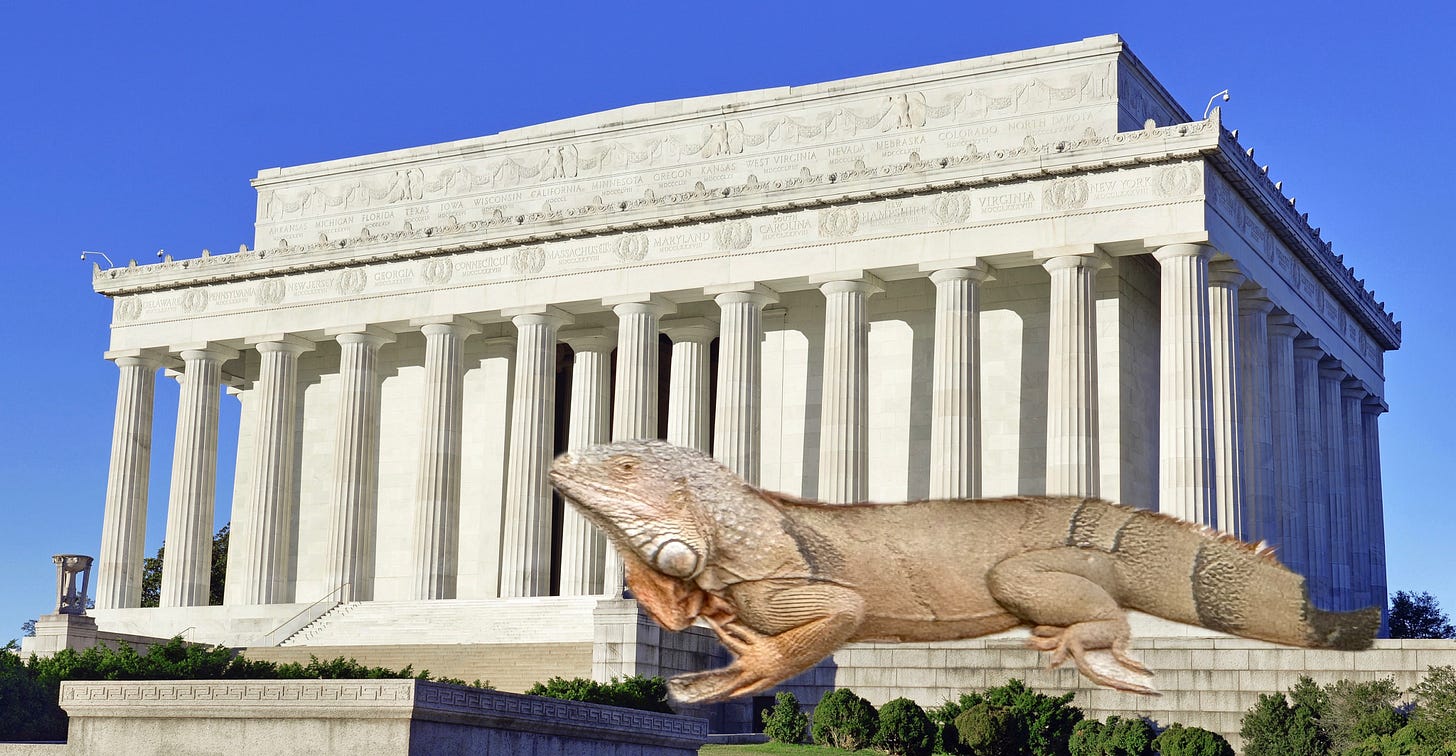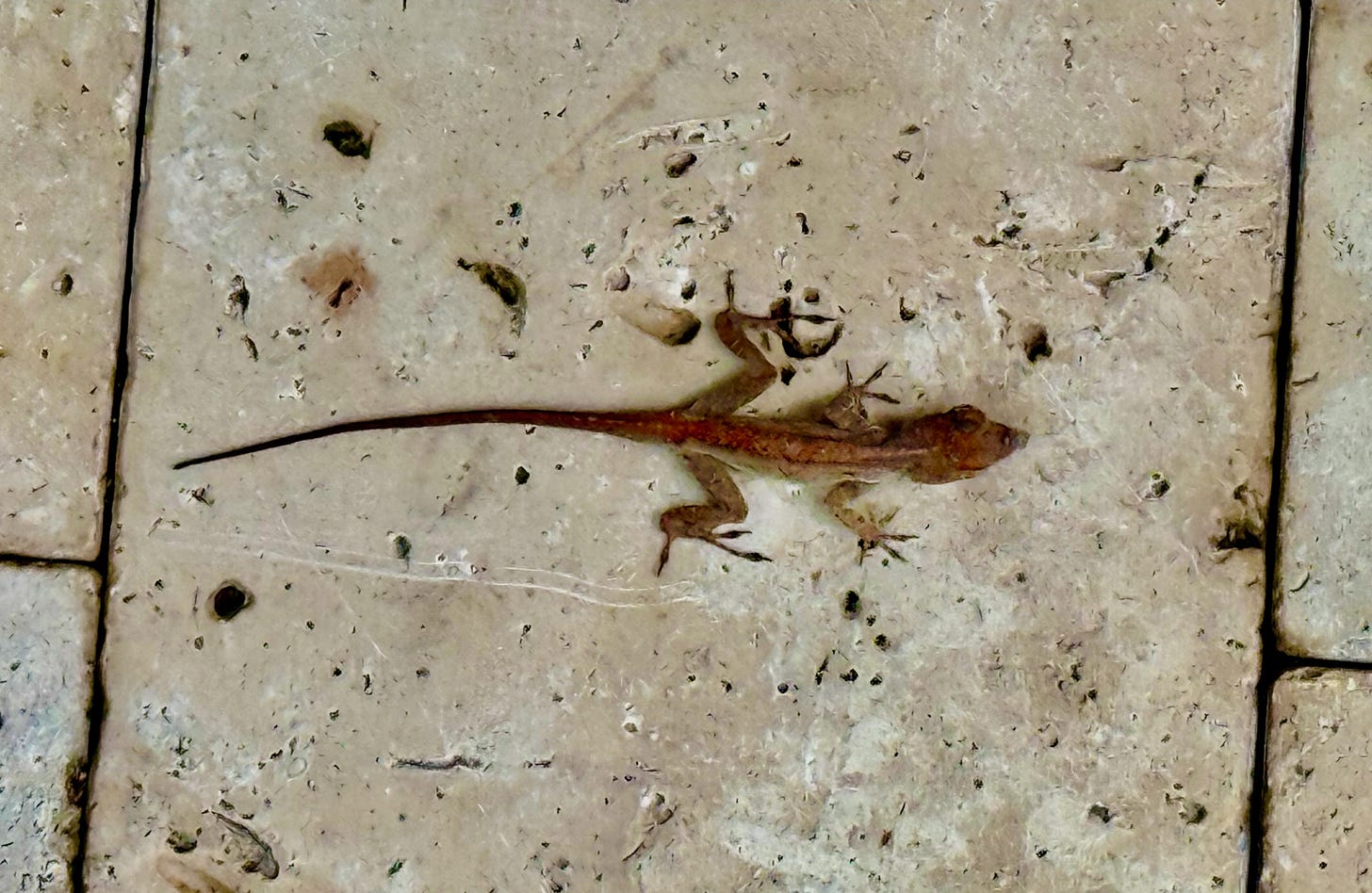We have an alarming lizard situation developing down here in South Florida.
The first thing you need to understand is that we have a very large lizard population. How large, you ask? If you’ll let me get a word in edgewise, I will tell you. There are currently estimated to be 850 bajillion lizards residing in my neighborhood alone. This is not a guess. This is a scientific assessment based on literally hours of walking around.
It's not just lizards, of course; we have a tremendous amount of wildlife in general down here, because we don't have winter. If you live in a normal place such as Ohio, every year, just when the wildlife has gained a solid foothold, along comes winter — which biologists refer to as "Nature's Great Big Can of Raid" -— to kill everything, which means the wildlife has to start all over again in spring. As a result, nothing up there gets too numerous or too big.
It's different here. Everything keeps right on reproducing and growing and festering. During the peak summer rainy season (February-November) we have to mow our lawns like every 45 minutes. We have grasshoppers the size of LeBron James. We have cockroaches that, for safety reasons, emit loud piercing beeps when they back up.
Even our birds are weirdly large. In our neighborhood we have peacocks, which probably sounds exciting and exotic to you, but that's because you don't have these giant pigeons from hell barging around your neighborhood squawking and having sex and scratching your car and emitting biblical quantities of excrement. Here's a video I took this morning of two suspicious male peacocks lurking near my house, clearly up to no good. Notice how they skulk away in a furtive manner once they realize their faces might be seen on Substack:
And that’s only a small fraction of the nonstandard wildlife down here. We also have alligators, insanely long snakes, toxic toads and lately what ecologists describe as a "dangerously high concentration" of New Yorkers.
But it's the lizards I want to talk about today. The largest lizards we have down here are iguanas, which even by lizard standards are unattractive, which is why they're always in a grumpy mood. Here's a photo of a male iguana I will call Rex (not his real name) whom I often see loitering on a rock wall near my house:
To give you a sense of scale, here's Rex standing next to a familiar object:
So iguanas can get pretty big. But generally they stay outside, where they pose no threat to humans, unless of course you get within striking distance, in which case they will kill and eat you. At least that's what I assume they would do. I never go anywhere near them.
It's the smaller lizards that we South Floridians are more likely to come into contact with. For many years the most common kind has been the anole (pronounced "anole") which is an extremely skittery lizard roughly the size of a smallish lizard. Here's one I will call Buddy (his real name) on my patio:
Anoles are all over the place down here. You see them everywhere outdoors, although they also like to come inside houses. I don't know why. Maybe they're trying to get away from the iguanas. Whatever the reason, they regularly appear inside — sometimes on the floor; sometimes standing casually on the wall or upside-down on the ceiling — and when that happens, you — and by "you," I mean "I" — have to stop whatever you're doing, even if what you're doing is sleeping soundly, because your wife, Michelle, is going to remain in a state of DEFCON 1 Spousal Alert until you get the lizard out of the house.
Over the years I have developed a four-step system for lizard removal:
Step 1. Holding a Tupperware container and a piece of cardboard, I quietly enter the room containing the lizard, while Michelle waits nervously in a completely different part of the house.
Step 2. I creep stealthily up to the lizard, and then, with a sudden, swift motion I slam the Tupperware down.
Step 3. I carefully slide the cardboard under the Tupperware, thereby sealing it shut.
Step 4. With the cardboard firmly pressed against the Tupperware, I carry it outside, where I pretend to let the lizard go. I have to pretend because I did not actually catch the lizard back in Step 2. The lizard easily skittered away, using the lightning-quick reflexes that lizards have evolved over millions of years of evading predatory kitchenware. Of course this means that the lizard is still somewhere in the house. But I'm not going to tell Michelle, and neither is the lizard. If she had any idea what was going on, we would have moved to Ohio years ago.
Anyway, for a long time the South Florida lizard population consisted mainly of iguanas and anoles. It was what biologists call a Two-Lizard System, and everything was fine. But now we're facing an alarming new development on the lizard front — a development related to the same global environmental phenomenon that has caused so much disruption in recent years. I am referring, of course, to: Elon Musk.
No, seriously, I'm referring to global climate change, which turns out to be connected to the lizards. I found out about this from an article in the Miami Herald written by climate-change reporter Denise Hruby, headlined:
How a turf war between lizards in Florida impacts mosquitoes and maybe your health
If I understand this article correctly — and I think we can all agree that I probably don't — it says there's a new invasive lizard down here called the Peter's rock agama, which is larger and more badass than the anoles and is muscling in on their territory. Here's a photo of one preparing to steal a concrete block:
So as the Peter's rock agamas move in, the anoles are disappearing. Scientists worry that this could be bad for humans, because (this gets complicated, so follow me closely):
-- Anoles are a major source of blood for mosquitoes.
-- Anoles sleep out in the open at night, which means it's easy for mosquitoes to suck their blood.
-- But the Peter's rock agamas sleep inside crevices, so the mosquitoes can't get to them.
-- Therefore, as the anoles disappear, the mosquitoes will have to find a new source of blood.
-- That source, as you have probably already guessed, will be: Elon Musk.
No, seriously, it's birds. This is bad for humans, because unlike anoles, birds contain scary diseases. Scientists are worried that mosquitoes — whose numbers are increasing because of global climate change — will start sucking more blood from birds, and consequently transmitting more diseases to humans, such as (to pick a name at random) Elon Musk.
So we have a crisis looming, and unless we are able to solve it — not to be an alarmist — you personally will probably be dead within hours.
What can we, as a nation, do about this? One possible solution would be to restore the anole population by getting rid of all the Peter's rock agamas. But that would require a massive commitment of resources, and I frankly question whether we, as a nation, have enough Tupperware.
Anyway, it's not my job to provide solutions. It's my job, as a professional journalist, to provide just enough information to make you feel menaced by evil forces completely beyond your control. My work here is done.
So now it's time for you paying subscribers — who are, frankly, the only hope for humanity — to weigh in on this scientific poll:






A local zoo had a “donate $15 to name a cockroach” fundraiser. I donated $45 and named them Donald, JD, and Elon. Best $45 I’ve ever spent.
True story: In the late 1970s, Marion’s parents moved from something like the 200th floor of a condo in Boynton Beach to an earthbound patio home in Tamarac. Within about six minutes, our phone rings in Davie and I can hear Marion’s mother screaming: “There’s an alligator in my house!!!” Naturally, Marion’s only choice was to send me over there post haste to…you know…I really don’t know what. It’s a freaking alligator, right? Wrong. It’s a three-inch-long anole. “I got it,” I shouted triumphantly. Of course not. It’s probably still in a closet or something.